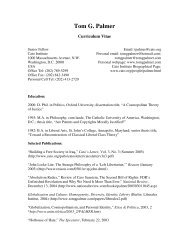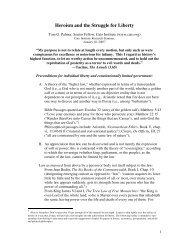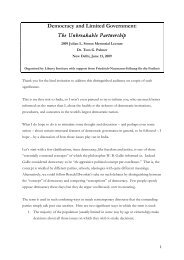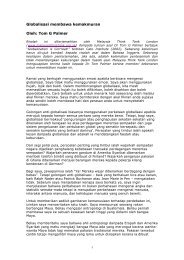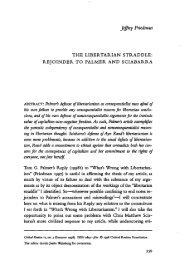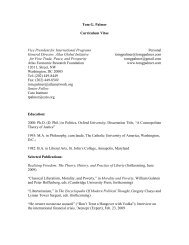Are Patents and Copyrights Morally Justified? - Tom G. Palmer
Are Patents and Copyrights Morally Justified? - Tom G. Palmer
Are Patents and Copyrights Morally Justified? - Tom G. Palmer
You also want an ePaper? Increase the reach of your titles
YUMPU automatically turns print PDFs into web optimized ePapers that Google loves.
820 HarvardJournal of Law & Public Policy [Vol. 13<br />
ceptions of property rights. Rather than looking to moral desert,<br />
or to maximization of utility, or to the omnipresence of<br />
scarcity, personality-based rights theories begin with a theory<br />
of the person. Often harkening back to Kant’s discussions of<br />
the nature ofauthorship <strong>and</strong> publication <strong>and</strong> to Hegel’s theory<br />
ofcultural evolution, personality-based rights theory forms the<br />
foundation of German <strong>and</strong> French copyright law. Several personality-based<br />
arguments will be considered in this Article. As<br />
we shall see, some of these approaches provide a foundation<br />
for a more expansive form of intellectual property rights than<br />
do moral desert or utilitarian theories, extending, for example,<br />
to artists’ inalienable “personal rights” 6 over their products.<br />
Utilitarian arguments of various sorts can either support or<br />
undercut claims for intellectual property rights. Contingent<br />
matters of fact form an especially important part of the utilitarian<br />
structure. As I have written elsewhere on the utilitarian arguments<br />
for <strong>and</strong> against intellectual property rights, 7 I will<br />
limit myselfin this Article to a few briefremarks on this subject.<br />
Attempts have also been made to derive intellectual property<br />
rights from the retention of certain tangible property rights.<br />
Thus, ownership rights to tangible objects are constituted by a<br />
bundle of rights that may be alienated or rearranged to suit<br />
contracting parties. In selling or otherwise transferring a piece<br />
of property, like a copy of a book for example, some of these<br />
rights may be reserved, such as the right to make additional<br />
copies. The owner of the material substratum in which an ideal<br />
object is instantiated may reserve the right to use the material<br />
substratum for the purpose of copying the ideal object. This<br />
argument might be labelled the “piggy-back” theory: The intellectual<br />
property right obtains its moral force from its dependence<br />
on a more conventional right of property.<br />
I will take the opportunity in parts II through V of this Article<br />
to present as clearly <strong>and</strong> fairly as possible each of these four<br />
kinds of property arguments. In turn, I will offer criticisms of<br />
6. Or droit moral, sometimes confusingly translated simply as “moral rights.”<br />
7. See <strong>Palmer</strong>, intellectual Property Rights: A Non-Posnenan Law <strong>and</strong> Economics Approach,<br />
12 HAMLINE L. REV. 261 (1989). This essay alsoreviews thehistory ofintellectualproperty.<br />
considers the problem of whether common-law copyright extends after theact of<br />
publication, reevaluates theeconomics of publicgoods <strong>and</strong> property rights, <strong>and</strong>examines<br />
how markets for ideal objects without intellectual property rights function. For<br />
criticism of my position, see Gordon, An Inquirj into the Menisof Copyright: The Challenges<br />
of Consistency, Consent, <strong>and</strong> Encouragement, 41 STAN. L. REV. 1343 (1989).



